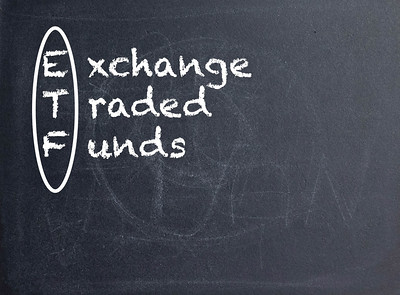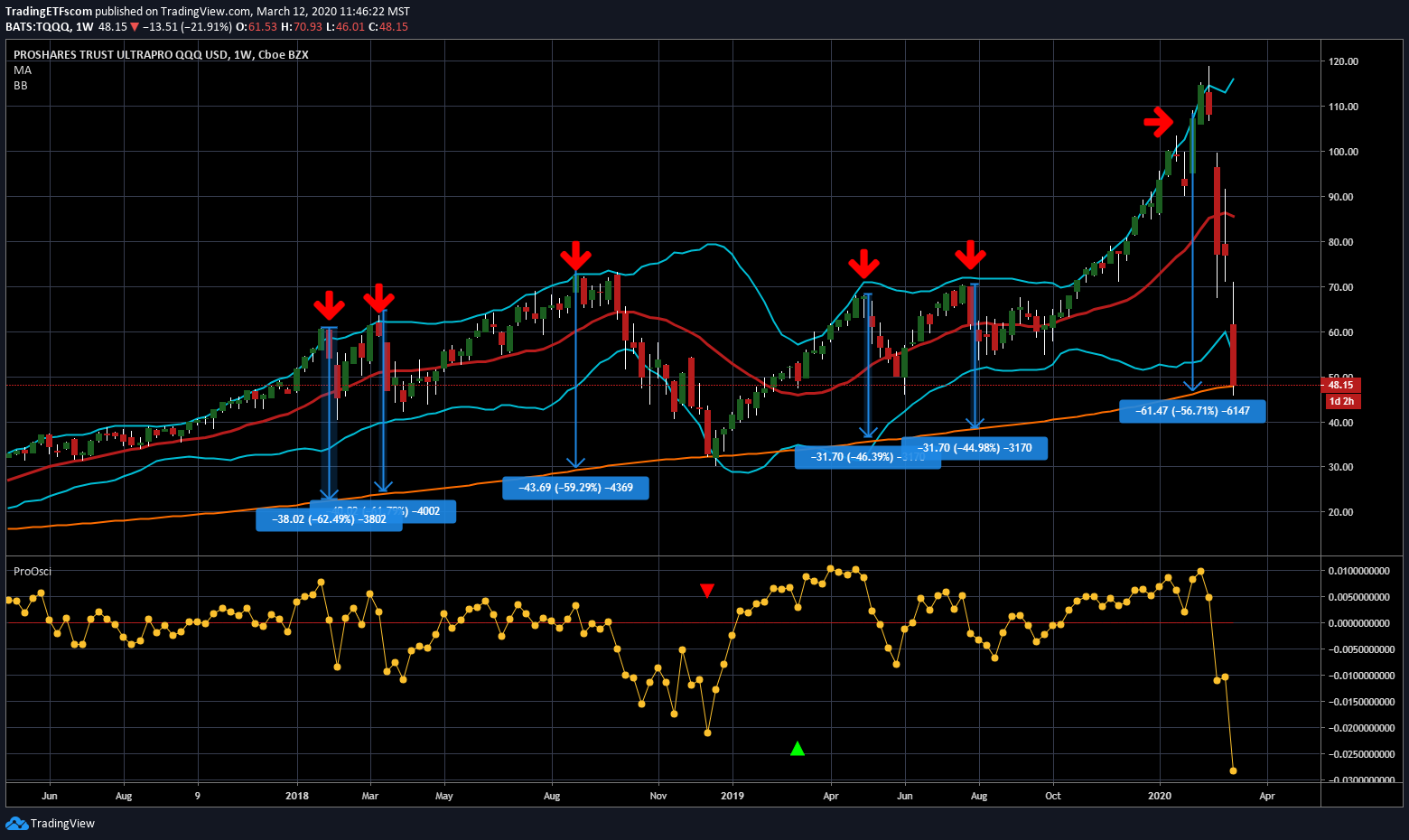How to Avoid Big Losses Trading ETFs like TQQQ
One of the most asked questions we get about Trading ETF’s like TQQQ is how can I Avoid Big Losses with Trading ETFs like TQQQ that destroys my trading account? This article explains a few of the techniques you can use to help identify when risk is in your favor or maybe you should keep your powder dry for a better opportunity.
There are times in trading when the market is moving in one direction or the other that allows a trader to easily define their risk based on the last high/low and then a stop loss or stop limit can be used to protect that trade. In the market we are currently in, which seems like a one- way ticket up, then everything changes in terms of risk. Let’s look at a few methods traders can use to help with Avoiding Big Losses with Trading ETFs like TQQQ.
Avoiding Big Losses Starts with Understanding What You are Trading
For this article we are using the ETF TQQQ but the methodology can be used for any ETF, Stock or Mutual Fund. The first step to avoiding big losses is knowing the top 10 holdings of the ETF and a great source to view this information is from Marketwatch.com. (click here to see the top 10 holdings of TQQQ). Now that you know the top 10 holdings and can see this ETF will move in the direction of the largest tech companies in the world but with 3X leverage, a 1% move in the QQQ will be equivalent to a 3% move in TQQQ. This works great when your trade is on the right side of the market and horrible when you’re on the wrong side.
***WE PROVIDED AN UPDATED CHART
Your Risk Tolerance and Your Holding Period Will Decrease the Odds of Big Losses
When markets move to the extreme to the upside and downside traders tend to lose perspective on what type of trader they are and how long they planned on keeping the trade open. Before you enter a trade you want to make sure the trade is consistent with your risk tolerance and your holding period for this trade. One tool you can use to check on these 2 factors is here: TQQQ info Macroaxis.com (click here to use the tool). This tool from Macroaxis.com will allow you to adjust your holding period and risk tolerance and their system will recommend Buy/Sell/Hold based on your criteria. This will help you see whether your potential trade is consistent with your plan on this trade.
So at this point you now know exactly what you’re trading and whether this trade aligns with your risk tolerance and holding period but now we need to determine whether this is the right time to put on a trade. Now let’s look at a few different strategies that will help you to determine whether it is the right time to enter the trade.
Use This 1 Method that will definitely Help to Avoid Big Losses Trading ETFs like TQQQ
Traders have often heard the term “Reversion to the Mean” and here is Investopia’s formal definition. To simplify the concept you can think of it this way. What goes up must come down and what goes down must come up in regards to trading in the markets. For example, a market that is extremely overbought will go up so high that it leaves no more buyers available to buy more. On the flip side, a market that is extremely oversold leaves no more sellers to keep selling which is also known as capitulation. Traders/investors have bought all they can and sold all they can. When you have either one of these 2 scenarios then massive market reversals have a high probability of occurring. In the WEEKLY chart below you can see whether the current TQQQ ETF is at extremes or not by using a simple 200 day moving average for the last 2.5 years.
The top section of the chart is where we are focusing at this point and you can see there are 6 different red arrows that have been placed at high points along the way. The orange line is the 200 day moving average and then you have the blue rectangles that show the difference between those high point prices and the 200 day moving average. Starting with the first red arrow on the left side of the chart you can see that the price topped out at approximately $60 and on that day the 200 day moving average was at $22. The difference between the 2 is $38 which is 61.9% from the high price to the 200 day moving average. With the 6 red arrows you can see that the percentages from the price point to the 200 DMA has been 62.49%, 61.96%, 59.29%, 46.39%, 44.98% and 56.71% which is where the current price of TQQQ to the 200 DMA currently stands. When you use this method you can make an assumption about the probabilities of whether the current move is subject to a massive reversal to the opposite direction. In this example, we can see that when levels reach 60% then big reversals have occurred and when they occurred it was quick and sharp to the downside. As of this last red arrow the percentage above the 200 DMA is 56% and this should be a red flag to any trader that a reversal is a higher probability then a continued move to the upside. Using this method helps a trader prevent getting caught up emotionally when everyone is feeling great about the current market news. Now let’s look at method 2 to confirm method 1.
Confirming Method 1 Increases Your Chance of Avoiding Big Losses
Many traders use Indicators to try to confirm their own bias and use them to give them a cheat sheet for entering/exiting trades. Examples of these are the MACD, RSI, Oscillators, and many others. All of them have their strengths and weaknesses but for this article we are going to use our own Oscillator to illustrate our point.
You can see in the bottom section of the chart we have also identified 3 red arrows when our oscillator has reached extreme overbought represented by the blue dots and the red line which is at the zero level. When the blue dots are above the zero line then momentum is positive and below the line momentum is negative.
In this example you can see that when the blue dot reaches the .14 – .16 level then a price reversal has a greater probability of occurring. Currently the blue dot is at .14 and that suggests that the odds are building that TQQQ is reaching a high point for this move since September 2019.
So now you have 2 methods that are consistent with each other and now you have a better view to make an informed decision prior to a trade.
**** We just completed an update video to show current price****
Let’s recap what we have explained in this article on “How to avoid big losses trading ETFs like TQQQ”.
Step 1 is to understand what you are trading so you know what will affect the price of the ETF by looking at the top 10 holdings of the ETF.
Step 2 is to decide how long you are planning to hold the position so it doesn’t change from a trade to a forced long term investment. Also, you need to know your risk tolerance and then make sure this trade is in alignment with that risk tolerance.
Step 3 is to find and use a method that allows you to objectively determine how extreme the ETF/Market is currently.
Step 4 is to confirm that extreme reading by using an indicator that either supports the extreme position or invalidates method 1. In our example method 2 confirmed method 1 and so you now know the risk that you will be wrong on this trade if you are looking to buy the TQQQ.
Step 5 is to then ask yourself “is there another trade that can be made to take advantage of this extreme position?”.
The Conclusion
Big losses are incurred when a trader doesn’t use a systematic method to determine whether a trade should be executed. The systematic method we described is not the only method a trader can use to reduce risk of big losses as there are many other methods that successful traders are using. However, we find most traders do not use a methodology prior to executing a trade and what ends up happening is they hope that the market will be kind to them but in the end they ask the question, How Can I Trade ETFs Without Incurring Big Losses?




